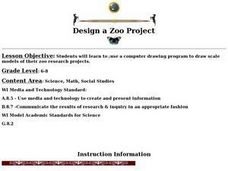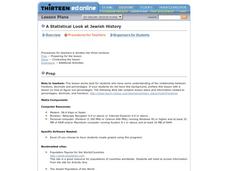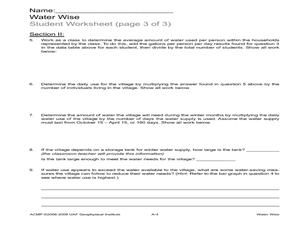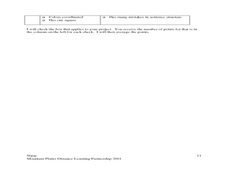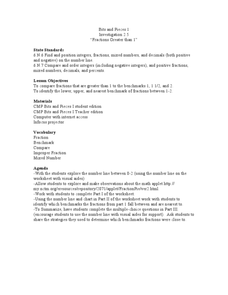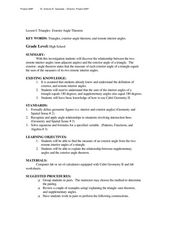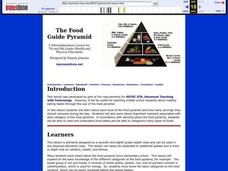Curated OER
Design a Zoo Project
Students research animals to become experts on them. They design a zoo to fit their animal's climate and region. They create a computer drawing of their zoo at the end of the lesson.
Curated OER
Balancing the Scales: Understanding Ratios
Students are introduced to the concept of ratios. In groups, they convert sets of numbers into a ratio. After practicing, they use the ratios and proportions to solve story problems. They also calculate map distances and discover map...
Curated OER
A Statistical Look at Jewish History
Students complete their examination over the Jewish Diaspora. Using population figures, they discover the importance of percentages in exploring trends. They use their own ethnic group and determine how it is represented in the United...
Curated OER
What Does It Matter?
Students define matter, the chemical properties of matter, and the physical properties of matter. They name physical and chemical properties of matter (by classifying using a Tree Map). Students determine the mass, volume, and density of...
Curated OER
Water Wise
Students calculate their family's water consumption. In this water usage instructional activity, students discuss the water they use in their homes. Students complete the 'water wise' worksheets to tally their family's use of water....
Curated OER
Introduction to Solving Quadratic Equations by Factoring
Learners solve quadratic equations. In this algebra lesson plan, students factor and graph linear and quadratic functions. They identify the standard and linear form of each equation.
Curated OER
What's Out There? Space Shuttle Exploration and Simulation
Students role-play the jobs of space shuttle astronauts, conduct experiments, and research space using the Internet and offline experiments. Student-astronauts hold a "press conference" to share their information with others in a...
PBS
Could You Start a Business?
High schoolers learn how a business starts and finds financial independence. For this lesson, students learn the struggle of financial management, the costs of running a business and how to keep a budget.
Curated OER
It's Your Future
Students learn about productive resources along with their requirements, supply and demand, savings, investments and interest rates. In this supply and demand lesson, students create a career plan and personal budget of their own and...
Curated OER
The REAL Cost of College
Students explore the cost of college and how to plan and save. In this money management lesson students do research on the cost of college, learn about making financial choices, earning, spending, saving, investing and how they apply to...
Curated OER
Why Does Money Have Value?
Middle schoolers study money and its value and usage in the world today. For this economic lesson, students research money as they learn what it stands for, why it is important, how it is valued and what it represents in the United States.
Curated OER
Scientific Notation
Learners explore the concept of expressing numbers in scientific notation. In this scientific notation instructional activity, students understand the importance of using scientific notation by finding real world examples where...
Curated OER
Don’t Sit Under the Apple Tree…You Might Become Famous
Students explore Newton's laws using CEENBoTs. In this physics lesson plan, students collect data and create tables and graphs. They calculate speed, acceleration and forces using mathematical formulas.
Curated OER
The Time of Man
Young scholars demonstrate visually Mankind's relative place on the earth's timeline. They familiarize themselves with the use of the metric system in measuring and producting a timeline.
Curated OER
Quilt Squares
Students research the history of the quilt in American History and view a PowerPoint Presentation. They create a quilt square with colored paper using polygons, transformations, rotations, and reflections on the computer and on a...
Curated OER
Mathematical Properties
Seventh graders discuss the associative property of math. They are to find examples of the property and others. They also write in their journals about what they learned.
Curated OER
Slope Right Up
Learners use triangles to find the length and slope of each side. After connecting the vertices, they add points based on their specific instructions. They use the Pythagorean Theorem to complete a worksheet to end the lesson.
Curated OER
Bits and Pieces: Fractions Greater Than One
Students compare fractions. In this fraction worksheet, students examine the number line. Using the Internet, they explore models of numbers greater than one. Students complete multiple-choice worksheets.
Curated OER
Triangle Exterior Angles Theorem
Students identify the measure of missing exterior angles. In this geometry instructional activity,students define and apply the exterior angle theorem to solve problems. They use Cabri software to create different angles and make...
Curated OER
What Makes Our Community Special?
Explore websites, complete research, and use technological tools to create a final multimedia presentation on what makes a community special. Learners of all ages work with a partner to research an interesting aspect of their community,...
Curated OER
Are You Thirsty? The Effects of Pollution on Drinking Water
Discuss the availability of clean, plentiful water and the causes of water pollution. In groups, sixth graders discuss problem-solving methods for keeping water clean. They explore the function of water treatment plants and perform...
Curated OER
Watershed Model
Students view a presentation of water and land and how we need to protect our water resources. In this water lesson plan, students discuss how we rely on water, and complete activities in all subjects related to water.
Curated OER
Marshmallow Moosy
Students stack several different colored marshmallows-one on top of the other-in the tall cylindrical container. They ct a cardboard disk to fit snugly inside of the container on top of the marshmallow stack using a compass if necessary....
Curated OER
The Food Guide Pyramid
Students examine each level of the food pyramid and how many servings they should consume during the day. They study the important nutrients associated with each category of the food pyramid.
